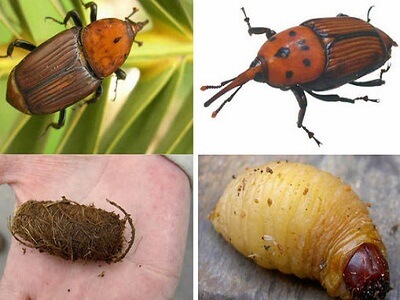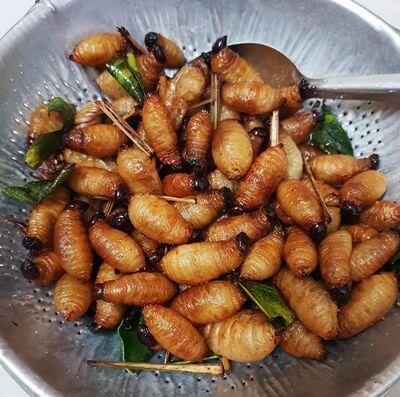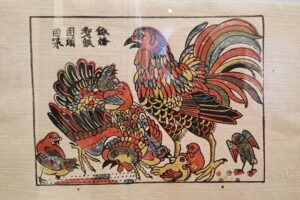Coconut worms used to be tasty food in the region of the Mekong Delta in Vietnam. However, coconut worms have not been allowed to sell, buy, or grow to protect the coconut trees and other plants in the same family. So, you have to notice this tip to avoid being punished with a lot of money.
To help some guests who are curious to study the worms of coconut, we introduce their features and some food that the locals used to make in the past.
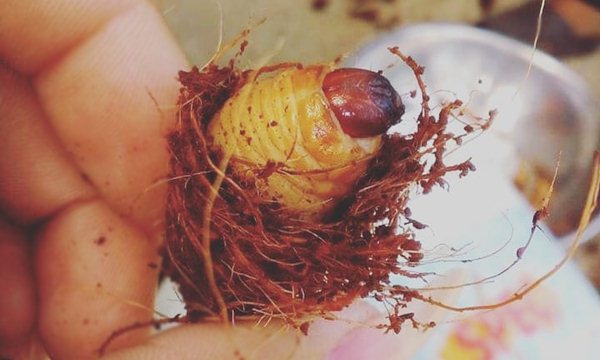
Coconut worms
Coconut worms, also called coconut weevils or Đuông dừa in Vietnamese, are larvae of the coconut beetles with the body not yet fully developed.
The worms live in coconut trees and eat the youngest part of the plants, so they contain plenty of healthy proteins. However, they are only as big as an adult’s index finger, about 3 to 5 cm long, and light yellow in their whole body.
We can only find coconut weevils when the leaves on the top of the coconut are wilted and collapsed. In the Mekong Delta, especially in Ben Tre province, worms can eat a lot of coconuts to death.
Usually, every year, after the mating season, dynastinae beetles often choose strong coconut trees to make holes in the tops to produce eggs.
The eggs hatch and grow up thanks to eating young coconut that is both soft and nutritious. They eat the top of the coconut tree until it is pierced, causing the tree to become exhausted and die.
So, all coconut worms are full of milk, fat, round, and limp, making many people look a little frightened with their outside appearance.
The life cycle of coconut worm
The average life cycle of coconut weevils is about 80-100 days, of which the egg period is 3-5 days, the larva is 50-70 days, and the pupa is 15-20 days. Coconut worms turn into coconut beetles that can live up to 3-4 months. Both larvae and weevils can cause damage to coconut trees, but mainly are worms.
When eating young coconut tops, the weevils make a barrier noise inside the trees, like the sound of a rice mill.
To know more about their life, we introduce you to the details below! Continue reading, please!
1. Egg stage:
Eggs are obtained by fertilization of male and female coconut beetles. During the breeding season, the beetles make holes in the tops of trees and lay eggs there. After spawning, the female secretes gastric juice that helps create a hard layer around the eggs to protect them. On average, a female produces 210 eggs per nest.
Characteristics of coconut worm eggs: eggs are white, cylindrical or oval, glossy, about 1-2.5mm in size. The back of the egg has a special structure that contributes to the supply of oxygen to the larvae.
2. Larval stage:
Over time, the eggs will hatch into larvae. This duration is the stage where we call those larvae the coconut worms or coconut weevils. At this stage, they will eat and absorb nutrients inside the soft part of the coconut tree to develop and grow.
Features of the larvae: Coconut larvae are white and yellow (infancy is white, and then they grow up to an adult stage and are yellow) and have no legs. The body has segmentation with a small brown head. The maximum size is 5cm.
3. Pupae stage:
Coconut weevils grow up and eat from the young part of the coconut, slowly going deep into the trunk. By reaching adulthood, they enter the next development stage of the life cycle.
Along with the environmental conditions the coconut tree provides, the dry brown trunk or the branches are worn down into fibers, and the coconut weevil will create a cocoon around itself into pupae.
Many people start eating coconut worms in the late second and early third stages. This duration produces the best worms with rich nutrition.
4. Stage into coconut beetle:
After successfully cocooning, coconut weevil becomes pupae and will develop in it. If anyone has ever watched the stages of butterfly development, most remember when the butterflies break their cocoons, step out, and spread their wings. The coconut weevil pupae have the same process; the young beetle also breaks the cover to get out.
Characteristics of coconut beetle: its size is 2 to 5cm and brown-red color. Coconut beetles can be considered badass pilots and can travel great distances.
Typical dishes made from coconut worms
A few people use coconut weevils to cook them with fish sauce, fry, grill, or boil. Here are the dishes used to eat from this special kind of ingredients to research.
1. Salty roasting coconut worms
Fresh worms are washed and placed in a saucepan with salt, sugar, and seasoning powder, similar to how silkworm pupae are made. Many families use this dish as a savory side dish with rice.
2. Breaded fried dish
After pre-processing, put a few peanuts into the body of the worms and roll them through the flour mixture of chicken eggs, a little pepper paste, and salt.
Fry them well in a fat pan. Then, stir over the butter to become more fragrant. After frying, let the fat drain, and eat coconut worms with raw vegetables to feel less fatty.
3. Baked with salt and chili
The coconut tree worms are skewered into bamboo sticks, grilled over charcoal until golden, then rolled with vegetables such as lettuce, tomato, basil, perilla, and green chili, and dipped into the tamarind fish sauce to enjoy.
4. Steamed sticky rice with worms
While steaming sticky rice, add some coconut worms to the surface. The rice and worms are cooked simultaneously.
People can eat coconut weevils with sticky rice. Also, they take the milk inside worm bodies to mix well with sticky rice.
Diners often enjoy this dish with sweet-sour fish sauce or roasted chicken.
5. Coconut-worm porridge
This simple porridge consists of coconut worms, pork, rice, ginger, green onions, spices, and a little coconut milk.
Particularly with coconut weevils, they need to have a careful process to do:
- wash the worms with cool water,
- put them in a cup of white rice wine for 2 minutes before taking them out,
- put the worms again in a cup of chili fish sauce for a few minutes,
- keep them in the refrigerator to make them better for a while.
This process helps to clean the worms and soak the spices, preventing the worms from breaking out when cooked.
This nutritious porridge is often used to foster health and increase vitality.
6. Bathing fish sauce
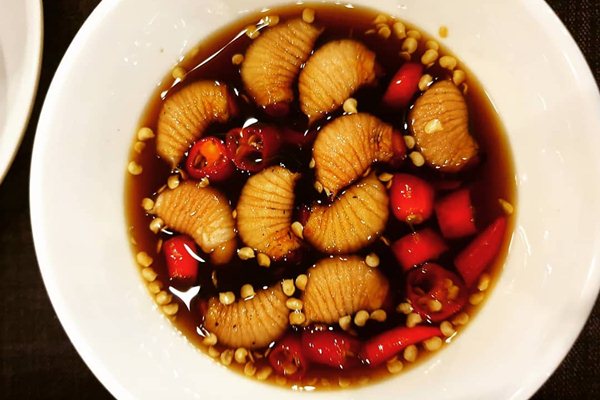
This way is to eat fresh worms alive, also called fun name – coconut weevils swimming in the river. It is because the fat worms swim in a bowl of spicy chili fish sauce.
Due to eating raw, many guests are not brave enough to try it, but the dish has high nutritional content.
Pick up a living weevil into your mouth, chew it slowly to let strange feelings spread, and you will feel the sweet taste, like egg yolk and cheese.
7. Boil with coconut water
The young weevils are fragrant and fatty after boiling with fresh coconut water.
This dish can be made by rolling traditional herbs with thin rice paper and dipping them into fish sauce mixed with lemongrass and minced chili.
8. Making coconut salad with weevils
This salad is made from the young coconut bud in the middle of the top of the coconut tree.
The chef slices the bud into small pieces and mixes them with bell peppers, green onions, lobster or shrimp meat, and crispy shrimp-puff cake.
Mix all the ingredients well, adding spices such as mustard, vinegar, and olive oil. Then, place the mixture on a plate and add fatty golden-fried coconut worms to it.
Frequently asked questions about coconut worms:
Are coconut worms safe to eat?
In general, coconut worms are okay to eat when many Vietnamese people can taste them. Typically, beer or wine drinkers like to enjoy these worms.
However, this food is strange for foreign tourists, and the local government does not allow the sale of coconut worms. Thus, please think twice before you try it!
What do coconut worms taste like?
Coconut worms taste like fresh milk. However, the feeling of looking at the worms and when to bite them is too different from that of normal food.
Where are the most coconut worms in Vietnam?
Most places to find this type of worm in Vietnam are in the Mekong Delta, where plenty of coconut trees are grown, specifically in Ben Tre province.
Coconut worms are harmful insects to coconut trees and other plants in the same family. Thus, they are not currently allowed to grow, buy, or sell.
Therefore, to protect coconut trees in Vietnam, especially in the Ben Tre region in the Mekong Delta, we do not encourage visitors to try coconut weevils.
Please try other tasty foods such as Vietnamese noodles, Banh mi Vietnam, or Banh Nam Hue!

